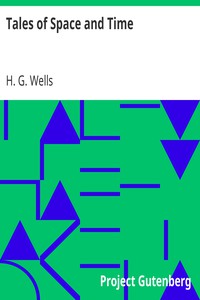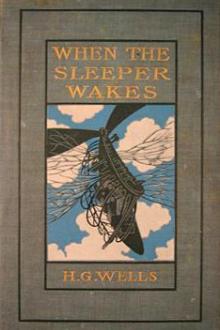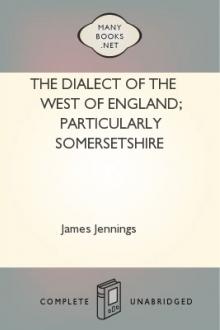Tales of Space and Time, H. G. Wells [best way to read an ebook txt] 📗

- Author: H. G. Wells
Book online «Tales of Space and Time, H. G. Wells [best way to read an ebook txt] 📗». Author H. G. Wells
He told a complicated story. The crystal he said had come into his possession with other oddments at the forced sale of another curiosity[12] dealer's effects, and not knowing what its value might be, he had ticketed it at ten shillings. It had hung upon his hands at that price for some months, and he was thinking of "reducing the figure," when he made a singular discovery.
At that time his health was very bad—and it must be borne in mind that, throughout all this experience, his physical condition was one of ebb—and he was in considerable distress by reason of the negligence, the positive ill-treatment even, he received from his wife and step-children. His wife was vain, extravagant, unfeeling, and had a growing taste for private drinking; his step-daughter was mean and over-reaching; and his step-son had conceived a violent dislike for him, and lost no chance of showing it. The requirements of his business pressed heavily upon him, and Mr. Wace does not think that he was altogether free from occasional intemperance. He had begun life in a comfortable position, he was a man of fair education, and he suffered, for weeks at a stretch, from melancholia and insomnia. Afraid to disturb his family, he would slip quietly from his wife's side, when his thoughts became intolerable, and wander about the house. And about[13] three o'clock one morning, late in August, chance directed him into the shop.
The dirty little place was impenetrably black except in one spot, where he perceived an unusual glow of light. Approaching this, he discovered it to be the crystal egg, which was standing on the corner of the counter towards the window. A thin ray smote through a crack in the shutters, impinged upon the object, and seemed as it were to fill its entire interior.
It occurred to Mr. Cave that this was not in accordance with the laws of optics as he had known them in his younger days. He could understand the rays being refracted by the crystal and coming to a focus in its interior, but this diffusion jarred with his physical conceptions. He approached the crystal nearly, peering into it and round it, with a transient revival of the scientific curiosity that in his youth had determined his choice of a calling. He was surprised to find the light not steady, but writhing within the substance of the egg, as though that object was a hollow sphere of some luminous vapour. In moving about to get different points of view, he suddenly found that he had come between it and the ray, and that the crystal none the less remained luminous.[14] Greatly astonished, he lifted it out of the light ray and carried it to the darkest part of the shop. It remained bright for some four or five minutes, when it slowly faded and went out. He placed it in the thin streak of daylight, and its luminousness was almost immediately restored.
So far, at least, Mr. Wace was able to verify the remarkable story of Mr. Cave. He has himself repeatedly held this crystal in a ray of light (which had to be of a less diameter than one millimetre). And in a perfect darkness, such as could be produced by velvet wrapping, the crystal did undoubtedly appear very faintly phosphorescent. It would seem, however, that the luminousness was of some exceptional sort, and not equally visible to all eyes; for Mr. Harbinger—whose name will be familiar to the scientific reader in connection with the Pasteur Institute—was quite unable to see any light whatever. And Mr. Wace's own capacity for its appreciation was out of comparison inferior to that of Mr. Cave's. Even with Mr. Cave the power varied very considerably: his vision was most vivid during states of extreme weakness and fatigue.
Now, from the outset this light in the crystal exercised a curious fascination upon Mr. Cave.[15] And it says more for his loneliness of soul than a volume of pathetic writing could do, that he told no human being of his curious observations. He seems to have been living in such an atmosphere of petty spite that to admit the existence of a pleasure would have been to risk the loss of it. He found that as the dawn advanced, and the amount of diffused light increased, the crystal became to all appearance non-luminous. And for some time he was unable to see anything in it, except at night-time, in dark corners of the shop.
But the use of an old velvet cloth, which he used as a background for a collection of minerals, occurred to him, and by doubling this, and putting it over his head and hands, he was able to get a sight of the luminous movement within the crystal even in the daytime. He was very cautious lest he should be thus discovered by his wife, and he practised this occupation only in the afternoons, while she was asleep upstairs, and then circumspectly in a hollow under the counter. And one day, turning the crystal about in his hands, he saw something. It came and went like a flash, but it gave him the impression that the object had for a moment opened to him the view of a wide and spacious and strange country; and, turning[16] it about, he did, just as the light faded, see the same vision again.
Now, it would be tedious and unnecessary to state all the phases of Mr. Cave's discovery from this point. Suffice that the effect was this: the crystal, being peered into at an angle of about 137 degrees from the direction of the illuminating ray, gave a clear and consistent picture of a wide and peculiar countryside. It was not dream-like at all: it produced a definite impression of reality, and the better the light the more real and solid it seemed. It was a moving picture: that is to say, certain objects moved in it, but slowly in an orderly manner like real things, and, according as the direction of the lighting and vision changed, the picture changed also. It must, indeed, have been like looking through an oval glass at a view, and turning the glass about to get at different aspects.
Mr. Cave's statements, Mr. Wace assures me, were extremely circumstantial, and entirely free from any of that emotional quality that taints hallucinatory impressions. But it must be remembered that all the efforts of Mr. Wace to see any similar clarity in the faint opalescence of the crystal were wholly unsuccessful, try as he would. The difference in[17] intensity of the impressions received by the two men was very great, and it is quite conceivable that what was a view to Mr. Cave was a mere blurred nebulosity to Mr. Wace.
The view, as Mr. Cave described it, was invariably of an extensive plain, and he seemed always to be looking at it from a considerable height, as if from a tower or a mast. To the east and to the west the plain was bounded at a remote distance by vast reddish cliffs, which reminded him of those he had seen in some picture; but what the picture was Mr. Wace was unable to ascertain. These cliffs passed north and south—he could tell the points of the compass by the stars that were visible of a night—receding in an almost illimitable perspective and fading into the mists of the distance before they met. He was nearer the eastern set of cliffs, on the occasion of his first vision the sun was rising over them, and black against the sunlight and pale against their shadow appeared a multitude of soaring forms that Mr. Cave regarded as birds. A vast range of buildings spread below him; he seemed to be looking down upon them; and, as they approached the blurred and refracted edge of the picture, they became indistinct. There were also trees curious in shape, and in colouring, a deep[18] mossy green and an exquisite grey, beside a wide and shining canal. And something great and brilliantly coloured flew across the picture. But the first time Mr. Cave saw these pictures he saw only in flashes, his hands shook, his head moved, the vision came and went, and grew foggy and indistinct. And at first he had the greatest difficulty in finding the picture again once the direction of it was lost.
His next clear vision, which came about a week after the first, the interval having yielded nothing but tantalising glimpses and some useful experience, showed him the view down the length of the valley. The view was different, but he had a curious persuasion, which his subsequent observations abundantly confirmed, that he was regarding this strange world from exactly the same spot, although he was looking in a different direction. The long façade of the great building, whose roof he had looked down upon before, was now receding in perspective. He recognised the roof. In the front of the façade was a terrace of massive proportions and extraordinary length, and down the middle of the terrace, at certain intervals, stood huge but very graceful masts, bearing small shiny objects which reflected the setting sun. The import of these small objects did not[19] occur to Mr. Cave until some time after, as he was describing the scene to Mr. Wace. The terrace overhung a thicket of the most luxuriant and graceful vegetation, and beyond this was a wide grassy lawn on which certain broad creatures, in form like beetles but enormously larger, reposed. Beyond this again was a richly decorated causeway of pinkish stone; and beyond that, and lined with dense red weeds, and passing up the valley exactly parallel with the distant cliffs, was a broad and mirror-like expanse of water. The air seemed full of squadrons of great birds, manœuvring in stately curves; and across the river was a multitude of splendid buildings, richly coloured and glittering with metallic tracery and facets, among a forest of moss-like and lichenous trees. And suddenly something flapped repeatedly across the vision, like the fluttering of a jewelled fan or the beating of a wing, and a face, or rather the upper part of a face with very large eyes, came as it were close to his own and as if on the other side of the crystal. Mr. Cave was so startled and so impressed by the absolute reality of these eyes, that he drew his head back from the crystal to look behind it. He had become so absorbed in watching that he was quite surprised to find himself in the cool darkness of[20] his little shop, with its familiar odour of methyl, mustiness, and decay. And, as he blinked about him, the glowing crystal faded, and went out.
Such were the first general impressions of Mr. Cave. The story is curiously direct and circumstantial. From the outset, when the valley first flashed momentarily on his senses, his imagination was strangely affected, and, as he began to appreciate the details of the scene he saw, his wonder rose to the point of a passion. He went about his business listless and distraught, thinking only of the time when he should be able to return to his watching. And then a few weeks after his first sight of the valley came the two customers, the stress and excitement of their offer, and the narrow escape of the crystal from sale, as I have already told.
Now, while the thing was Mr. Cave's secret, it remained a mere wonder, a thing to creep to covertly and peep at, as a child might peep upon a forbidden garden. But Mr. Wace has, for a young scientific investigator, a particularly lucid and consecutive habit of mind. Directly the crystal and its story came to him, and he had satisfied himself, by seeing the phosphorescence with his own eyes, that there really[21] was a certain evidence for Mr. Cave's statements, he proceeded to develop the matter systematically. Mr. Cave was only too eager to come and feast his eyes on this wonderland he saw, and he came every night from half-past eight until half-past ten, and sometimes, in Mr. Wace's absence, during the day. On Sunday afternoons, also, he came. From the outset Mr. Wace made copious notes, and it was due to his scientific method that the relation between the direction from which the initiating ray entered the crystal and the orientation of the picture were proved. And, by covering the crystal in a box perforated only with a small aperture to admit the exciting ray, and by substituting black holland for his buff blinds, he greatly improved the conditions of the observations;





Comments (0)